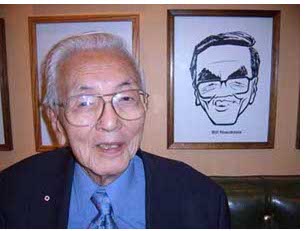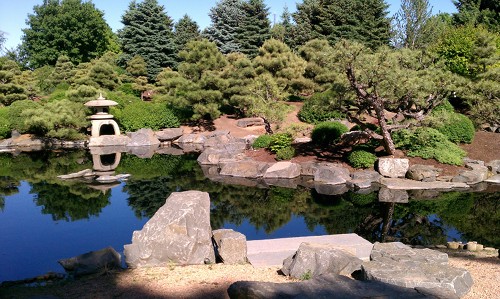11 Jul Denver pays tribute to Bill Hosokawa, a Japanese American leader
Many Japanese Americans – especially older JAs – will be familiar with the name Bill Hosokawa.
He wrote a column, “From the Frying Pan,†which was a running commentary on Japanese America that ran in the Pacific Citizen, the national newspaper of the Japanese American Citizens League (JACL), a civil rights organization, for decades. In 1969 he published the first comprehensive history of Japanese Americans, “Nisei: The Quiet Americans,†that included information about internment. In 1982 he published “JACL: The Quest for Justice,†a history of JACL. He also published a collection of “Frying Pan†columns with added observations in 1998.
His final book, published in 2005, was “Colorado’s Japanese Americans: From 1886 to the Present,†which most Japanese Americans across the country probably aren’t familiar with, but was well-received here in Colorado. Even at age 90, when he wrote the book, he was an agile wordsmith and a witty and straightforward storyteller, a gift that served him well in his long career as a journalist. He died two years later, in 2007.
 I was interviewed for an obituary in the LA Times when Bill died, and the reporter couldn’t understand how important “Nisei†was to a JA kid in northern Virginia in the early ’70s, where my family lived when I first read Bill’s landmark book. Being in a multicultural place like California with Asian faces everywhere you look, a book about the history of Japanese Americans may seem unremarkable. The Times’ obit even pointed out that to the emerging third-generation activists who were radicalized and beginning to actively seek their identity, “Nisei†seemed tame and even reinforced stereotypes of the meek, accommodating model minority.
I was interviewed for an obituary in the LA Times when Bill died, and the reporter couldn’t understand how important “Nisei†was to a JA kid in northern Virginia in the early ’70s, where my family lived when I first read Bill’s landmark book. Being in a multicultural place like California with Asian faces everywhere you look, a book about the history of Japanese Americans may seem unremarkable. The Times’ obit even pointed out that to the emerging third-generation activists who were radicalized and beginning to actively seek their identity, “Nisei†seemed tame and even reinforced stereotypes of the meek, accommodating model minority.
But to me, a kid in a northern Virginia suburb with no Asian friends — a banana if there ever was one — “Nisei†was like an electric jolt of identity. The radicalism came later; the first step for me was realizing that there were other people like me with an Asian face and Japanese values, but American heart and spirit.
Colorado is more like Virginia when it comes to Asian population and JA identity. I’m much more a part of an Asian American community now, but it’s a small and disparate one. So having a historical giant like Bill Hosokawa in the area was like having a lighthouse in a fog.
Bill Hosokawa was well-known nationally as one of the foundations of the Japanese American community’s national history.
He’s also remembered in Colorado, and not just by Japanese Americans. His legacy looms large in Denver and throughout his adopted state for his work as a writer and editor, and a diplomat who built lasting bridges with Japan. He was, as he quite accurately used to quip, “The most famous Japanese American in Japan.†And Colorado, too.
That legacy is being celebrated with an appropriate acknowledgement: A Bill Hosokawa Memorial Committee (full disclosure: to which I’ve recently been drafted) is overseeing the sculpting of a bust of Hosokawa to be reproduced and placed in two locations: The Denver Public Library main branch downtown, and the Denver Botanic Gardens. The Denver Botanic Gardens is paying further tribute by naming its redesigned and expanded Japanese Gardens the Bill Hosokawa Bonsai Pavilion and Japanese Garden.
Bill’s reputation outside of the Japanese American community reflects his many years as a reporter and editor with The Denver Post.
He arrived at the Post right after the end of World War II. Originally from Seattle, he studied journalism but wasn’t able to find a job in the American press. He was famously told by a professor who suggested he change his major, because no newspaper would hire a “Jap.â€
So he worked for the Japanese Consulate in Seattle, then got a job editing a paper in Singapore. When war with the U.S. became inevitable, he returned to Washington, and was interned at Heart Mountain in Wyoming with his wife Alice and their kids. While imprisoned, he ran the Heart Mountain Sentinel, continuing his journalism career under duress. Luckily, he didn’t stay long: In 1943 he was able to find a job working for the Des Moines Register for the rest of the war.
Throughout his career at the Post, he held every role imaginable in a newsroom. He was a war correspondent in Korea and Vietnam, and he swerved as the Editor of the Editorial Page. He ran the much-loved “Empire†Sunday magazine for 25 years. He left the Post in 1984 and finished his journalism career at the rival Rocky Mountain News where he was the paper’s ombudsman, the readers’ representative, until his retirement in 1992.
The entire time, he also maintained his “From the Frying Pan†columns in the JACL’s Pacific Citizen, and he also wrote a weekly column in Denver’s Japanese community newspaper, The Rocky Mountain Jiho. I was fortunate enough to join him as a columnist for the Jiho for a few years until the paper folded.
Outside of journalism, Hosokawa saw the importance of promoting better relationships with Japan. He was a founding force behind the Japan America Society of Colorado, which promotes cultural and business ties between the state and Japan. And, in 1976 he took on the role of Honorary Consul General of Japan in Colorado, a position he held until 1999, when Japan formally created a Consulate in Denver.
In 1994, I traveled with Bill on an exchange trip to Japan, where he charmed audiences with speeches that switched easily between English and Japanese, peppered with his dry sense of humor, and always, his journalist’s ability to make sharp observations and put them together in compelling stories. Japanese people loved him, from citizens to lawmakers and business leaders.
The bridges he helped build between Colorado and Japan are still paying dividends: The current negotiations to establish non-stop flights between Denver International Airport and Narita Airport outside of Tokyo may have evolved because of the business need for them, but the relationships Hosokawa helped establish are crucial to the talks. The Japan America Society and its leadership, for instance, are active supporters and involved in the efforts for the non-stop flights.
The Denver Botanic Gardens’ current Japanese Gardens is a much-loved feature of the institution and is one of the most popular attractions within the gardens. When the expansion is completed in 2012, it will include the current bonsai gardens and traditional tea house, but add an indoor area for more fragile bonsai and a space to host events; enhancements to the Tea Garden as well as a Sand and Stone Garden.
The Botanic Gardens is in the midst of a fundraising campaign to make these plans come to life. The goal is to raise $750,000 for the project, and more than $250,000 has been raised to date.
Bill would no doubt have been bemused by all the attention he’s receiving and the thought of having a prominent area of the Denver Botanic Gardens named after him.
It would have been interesting to read what he’d write about the hullaballoo. I bet it would have been funny, smart and humble – that’s how he lived his life, and how he wrote about it.





